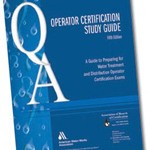
While the water treatment certification exam has become increasingly difficult as government regulations have become more stringent, the study guides simply have not kept pace.
The Class D water treatment certification exam administered by AMP (Applied Management Professionals) has a failure rate of over 50%. The Class A certification exam has a failure rate of over 90% each month.
If you are preparing to take the exam, these stats aren’t meant to scare you. This is to make you aware of the difficulty of the exam if you are not adequately prepared and to direct you to online resources on this and other websites that will help you be successful in passing the water treatment certification exam.

